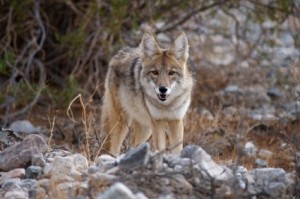 "I want to fly like the birds and be the greatest in all the world," wishes Wily Coyote. To indulge his desires, a playful flock of crows lend him their feathers, but when they realize how rude and boastful he is, they take them back. Unfortunately, Coyote is mid-flight when this happens, and in his fall from grace, he burns his tail and lands in the dust.
"I want to fly like the birds and be the greatest in all the world," wishes Wily Coyote. To indulge his desires, a playful flock of crows lend him their feathers, but when they realize how rude and boastful he is, they take them back. Unfortunately, Coyote is mid-flight when this happens, and in his fall from grace, he burns his tail and lands in the dust.
Trickster tales, such as the Native American one just mentioned, are imaginative narratives that usually use animals (but sometimes humans) to convey folk wisdom and help us understand human nature. Told mostly for fun and laughs, they can be found almost anywhere: Europe, Asia, Africa, the Pacific Islands, Australia, and North America.
Tricksters, usually male, have different faces and different talents. They can be foolish, childish, greedy, footloose, and mean spirited, but they can also be helpful, sympathetic, lovable, generous, and clever. Whatever . . . they don't follow rules, and they trick others to get what they want. In so doing, those Ravens, Rabbits, Turtles, Coyotes, Foxes, Spiders, and Monkeys of folklore are often the victims of trickery themselves.
Through the years, our pop culture has "watched" other tricksters come and go: Felix the Cat, The Tramp, Bugs Bunny, Woody Woodpecker, Pippi Longstocking, The Riddler, The Pink Panther,The Great Gazoo, Ferris Bueller, and Tyler Durden, to name a few. They delighted audiences with their rule bending and questioning of authority, their impulsiveness and creativity, but in the end their wits and instincts failed to adapt to the changing times and now they're mostly memories.
Yesterday's tricksters were hilarious; not so funny however are those in the forefront today:
Makes you wonder about some of our elected officials, financial advisers, attorneys, etc., etc.